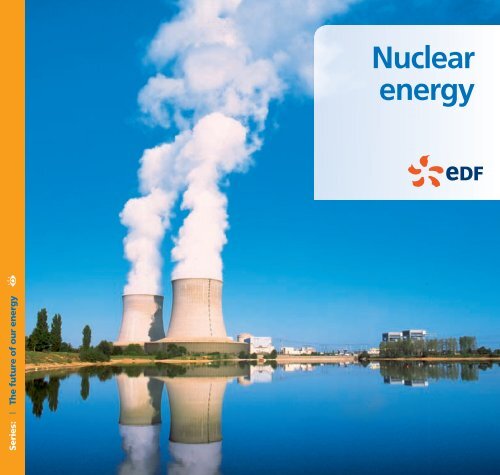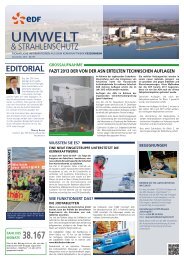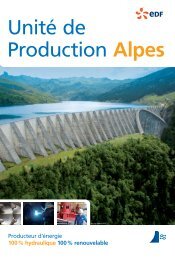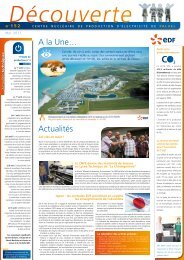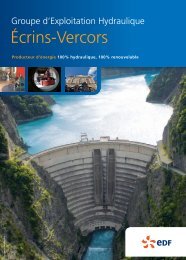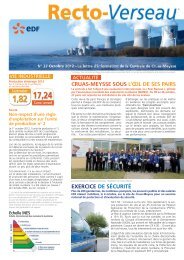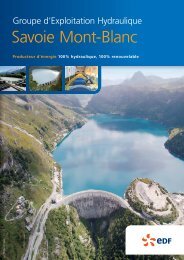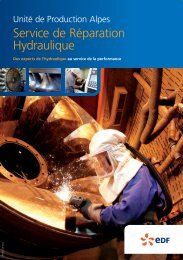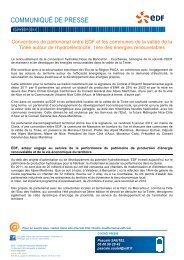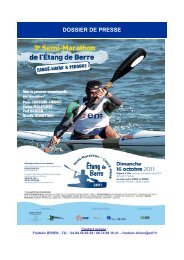Nuclear Energy - Energie EDF
Nuclear Energy - Energie EDF
Nuclear Energy - Energie EDF
Create successful ePaper yourself
Turn your PDF publications into a flip-book with our unique Google optimized e-Paper software.
Series: | The future of our energy<br />
<strong>Nuclear</strong><br />
energy
“How to reconcile power<br />
generation with environmental<br />
protection?”<br />
“Is <strong>EDF</strong><br />
competitive?”<br />
“25% of the world’s<br />
population uses almost<br />
two thirds of the world’s<br />
energy resources.”<br />
PERFORMANCE<br />
SAFETY<br />
ENERGY EXPERTISE<br />
A key player in the landscape of energy<br />
challenges, <strong>EDF</strong> generates ample quantities<br />
of energy in varied and environmentallyfriendly<br />
forms, thus providing the wider<br />
public with access to electricity.<br />
“<strong>Energy</strong> demand could<br />
increase by 60% by the<br />
year 2030.”
<strong>EDF</strong>,<br />
EUROPEAN LEADER<br />
IN POWER<br />
GENERATION<br />
The <strong>EDF</strong> group has a stake in the main<br />
leading European energy markets:<br />
the United Kingdom with <strong>EDF</strong> <strong>Energy</strong>,<br />
Italy with Edison, and France where <strong>EDF</strong><br />
is leader in its market. With its mix of<br />
nuclear, hydroelectric, fossil-fi red and<br />
other renewable energies, <strong>EDF</strong> operates a<br />
highly effi cient, diversifi ed and<br />
comprehensive power generation fl eet.<br />
POWER GENERATED BY <strong>EDF</strong><br />
IN MAINLAND FRANCE, 2010*<br />
407.9 TWh<br />
86.7%<br />
<strong>Nuclear</strong><br />
45.4 TWh<br />
9.7%<br />
Hydroelectric**<br />
16.9 TWh<br />
3.6%<br />
Fossil-fi red<br />
* These fi gures are rounded off to one decimal point as compared with<br />
exact values.<br />
** Including power generated by pumped-storage plants.<br />
INSTALLED CAPACITY<br />
in France as at 31 December 2010.<br />
NATIONAL POWER OUTPUT*<br />
were generated by <strong>EDF</strong> in France in 2010.<br />
of the electricity generated<br />
by <strong>EDF</strong> does not emit greenhouse<br />
gases.<br />
FRENCH FLEET<br />
19 nuclear<br />
power plants<br />
439<br />
hydroelectric<br />
plants<br />
UNITS OF MEASUREMENT<br />
• Mechanical and electrical power is measured<br />
in Watts (W).<br />
• The megawatt/hour (MWh) is the amount of<br />
power generated by a 1-megawatt (MW)<br />
generation facility within a one-hour period.<br />
• 1 MW = 1 000 kilowatts (kW) = 1 million watts.<br />
• 1 terawatt/hour (TWh) is equal to<br />
1 billion kWh.<br />
23 fossil-fi red<br />
plants<br />
and<br />
13 gas<br />
turbines
December 13, 2007.<br />
Gravelines nuclear<br />
power plant<br />
Mickaël Lenfant,<br />
apprentice, with<br />
Jérôme Leboucher,<br />
electromechanical<br />
engineer, and Lionel<br />
Lourdel, his mentor.
Cover:<br />
Saint-Laurentdes-Eaux<br />
nuclear<br />
power plant.<br />
04<br />
Securing energy<br />
independence<br />
<strong>Nuclear</strong> power,<br />
a vital energy<br />
source<br />
06<br />
Safety,<br />
an absolute<br />
priority<br />
Keeping a close<br />
watch on the<br />
French nuclear<br />
fl e e t<br />
08<br />
From the atom<br />
to electrical<br />
power:<br />
how does<br />
it work<br />
Understanding<br />
how a nuclear<br />
power plant<br />
works<br />
10<br />
<strong>Energy</strong><br />
for the future<br />
<strong>Nuclear</strong> power<br />
and tomorrow’s<br />
economic and<br />
environmental<br />
challenges<br />
Creation of series: Spécifi que<br />
Production and design:<br />
Translation: Concept & Langage – Photo credits: Onoky/<br />
Photononstop, Getty Images/DR, <strong>EDF</strong> media library/Marc<br />
Didier, Philippe Dureuil, Laurent Mayeux, Laurent Vautrin<br />
Printers: JPA - REF.ENE961-2011<br />
Printed on 50% recycled, 50% FSC paper.<br />
<strong>Nuclear</strong> power: mainspring of<br />
electrical power generation<br />
In order to supply clean, constant and<br />
affordable electricity to all its customer bases,<br />
regardless of location, <strong>EDF</strong> uses all sources of<br />
energy: nuclear fuel, water, coal, fuel oil,<br />
ever increasing amounts of wind energy, solar<br />
energy and biomass. <strong>Nuclear</strong> power<br />
continuously forms the basis of French energy<br />
supply while other energy sources such as<br />
fuel oil, coal and water, are periodically used<br />
to cope with peaks in energy demand, during<br />
very cold period, for instance. These other<br />
generation facilities are able to supply<br />
electricity very promptly. Within this mix,<br />
nuclear energy constitutes the “bedrock”<br />
of <strong>EDF</strong>’s power generation.<br />
www.edf.com
<strong>Nuclear</strong> energy<br />
SECURING<br />
ENERGY<br />
INDEPENDENCE<br />
<strong>Nuclear</strong> power accounts for 21% of all electrical power generated around the world. France<br />
opted for this form of energy in the post-war years, when the country decided to conduct<br />
research into means of developing this new energy source. France’s decision was corroborated<br />
in the nineteen-sixties, and particularly in the aftermath of 1973 and the petrol crisis, a year<br />
which saw the cost of the barrel quadruple within a mere few weeks. At the time, France was<br />
sourcing 76% of its energy supplies from other countries, and oil accounted for 84% of its<br />
imports.<br />
The decision to build a nuclear fl eet was taken with a view to securing France’s energy<br />
independence.<br />
This turned out to be a wise decision: By the late eighties, more than half of energy demand<br />
was already covered by the country’s output.<br />
<strong>EDF</strong> is now the world’s leading producer of nuclear energy. It enjoys world-wide renown as<br />
the leading light in technical know-how.<br />
<strong>Nuclear</strong> energy is now increasingly perceived as a crucial source of energy. Global energy<br />
demand continues to rise while petroleum and gas resources, and coal resources in the longer<br />
term, will be in short supply. Not to mention the need to combat global warming. <strong>Nuclear</strong><br />
power does not generate greenhouse gases.<br />
04<br />
RESEARCH<br />
In 1956, The Atomic<br />
<strong>Energy</strong> Commission<br />
(CEA) started up<br />
the very fi rst French<br />
reactor at the<br />
Marcoule facility<br />
(Gard). <strong>EDF</strong><br />
connected a power<br />
generator at the<br />
site.
<strong>Energy</strong> resources<br />
of the future<br />
By the year 2030, global energy<br />
demand is expected to have<br />
risen by 60%, while global<br />
electricity demand is expected<br />
to double within the next 30<br />
years. In the light of these<br />
forecasts, oil resources are<br />
expected to be depleted within<br />
the next 40 years, with natural<br />
gas becoming depleted within<br />
the next 70 years, and coal<br />
within the next 200 to 300<br />
years. Uranium resources, on<br />
the other hand, are found in<br />
abundance. They come from<br />
stable countries like Canada<br />
and Australia. Given the<br />
challenges facing energy<br />
supply, nuclear energy stands<br />
out as a sustainable and<br />
economic solution.<br />
The French nuclear<br />
fl eet in fi gures<br />
Two types of nuclear power<br />
plant have been built in France:<br />
French-designed gas-cooled<br />
nuclear reactors, and Americandesigned<br />
pressurized water<br />
reactors (PWR). In the nineteensixties,<br />
6 gas-cooled reactor<br />
units were commissioned,<br />
while 58 PWR plants were<br />
commissioned between 1970<br />
and 1993. The French nuclear<br />
fl eet now comprises 58 reactor<br />
units spread across 19 nuclear<br />
power stations: thirty-four<br />
900-MW reactors, twenty<br />
1300-MW reactors and four<br />
1500-MW reactors. Indeed, <strong>EDF</strong><br />
customers enjoy some of the<br />
most competitive electricity<br />
rates in Europe. France is the<br />
world’s second biggest nuclear<br />
energy power, after the United<br />
States.<br />
Reactor units. A reactor unit comprises<br />
one reactor, steam generators, a turbine and<br />
a generator, which produces electricity.<br />
DID YOU KNOW?<br />
<strong>EDF</strong>’s nuclear and hydroelectric<br />
generation facilities enable it to<br />
generate 95% of its electricity<br />
without emitting CO2.<br />
The Kyoto protocol has called for a<br />
5.7% reduction in CO2 emissions in<br />
industrialized countries over the<br />
period spanning 1990 to 2010 (8%<br />
for European countries).<br />
05
<strong>Nuclear</strong> energy<br />
SAFETY,<br />
AN ABSOLUTE<br />
PRIORITY<br />
Safety comprises all measures taken at each stage of a plant’s life span, starting<br />
with the design phase, to ensure that plant operations have no adverse effects<br />
on man and the environment. To achieve this aim, <strong>EDF</strong> relies on the high<br />
professional standards of its work force, on the meticulous attention and care<br />
they bring to their work, on the reliability of its generation facilities and on<br />
scrupulous adherence to regulations, under the watchful eye of the French<br />
nuclear regulatory authority.<br />
Two fundamental principles are applied in the endeavour to avert risk: “defence<br />
in depth”, which entails setting up a number of lines of defence by envisaging<br />
potential equipment and human failures, and “circuit redundancy”, which<br />
provides back-up safety systems. <strong>Nuclear</strong> fi ssion is also constantly monitored and<br />
can be stopped at any time. The reactor core is constantly being cooled and<br />
radioactive substances are contained behind successive barriers (see diagram).<br />
This safety culture is accompanied by strict measures to control impacts on man<br />
and the environment. Before a nuclear plant is even built, <strong>EDF</strong> conducts a<br />
radio-environmental survey of each site, the results of which serve as a base line<br />
for subsequent analyses. Throughout its service life, a plant is monitored on two<br />
levels: the on-site laboratory takes measurements and samples of air, water and<br />
fl ora within a 5-km radius, while the Department of Health and Industry then<br />
double-checks these samples. Similarly, liquid and gaseous effl uents produced<br />
by power plants undergo a number of operations prior to disposal, in order to<br />
reduce their radioactivity.<br />
06<br />
Reactor<br />
vessel<br />
1 st barrier:<br />
fuel<br />
cladding<br />
3 SAFETY BARRIERS SEPARATING NUCLEAR<br />
FUEL FROM THE ENVIRONMENT<br />
3 rd barrier:<br />
reactor<br />
containment<br />
structure<br />
THE NUCLEAR<br />
REGULATORY<br />
AUTHORITY<br />
On behalf of the<br />
State, the French<br />
nuclear regulatory<br />
authority (ASN)<br />
monitors nuclear<br />
safety and<br />
radiation<br />
protection in<br />
France, in order to<br />
protect workers,<br />
patients, the public<br />
and the<br />
environment from<br />
the risks associated<br />
with nuclear<br />
activity. Enjoying<br />
the status of an<br />
independent public<br />
authority, the ASN<br />
is also instrumental<br />
in providing the<br />
French public with<br />
information.<br />
Pressuriser<br />
Steam<br />
generator<br />
2 nd barrier:<br />
reactor<br />
coolant<br />
pressure<br />
boundary
Emergency drills<br />
Every year, each nuclear power<br />
plant conducts 7 to 8 emergency<br />
simulation drills in conjunction<br />
with the local and national<br />
public authorities, the aim being<br />
to train staff in responding to all<br />
types of emergency. Controlroom<br />
operators also receive six<br />
weeks of industrial safety<br />
training a year.<br />
The INES scale<br />
Waste management<br />
France came up with the<br />
International <strong>Nuclear</strong> Event Scale<br />
(INES) in 1987. The scale started<br />
being used internationally in the<br />
early nineties. Consisting of 7<br />
levels, it is used to gauge the<br />
signifi cance of events and<br />
accidents occurring on a nuclear<br />
facility.<br />
INCIDENT ACCIDENT<br />
7 Accident Major accident majeur<br />
6 Accident Serious accident grave<br />
5 Accident entraînant with wider un consequences risque hors du site<br />
4 Accident n’entraînant with local consequences pas un risque important hors du site<br />
3 Incident Serious incident grave<br />
2 Incident<br />
1 Anomalie Anomaly<br />
0 Ecart. No Safety Aucune Significance importance du point de vue de la sûreté<br />
<strong>EDF</strong> rigorously manages the waste produced by its nuclear power plants, by restricting the amounts of<br />
waste produced at source, by selectively sorting its waste into categories and activity levels, and by<br />
packaging its waste appropriately. Repositories are already in place for the disposal of “short-lived”<br />
waste produced in the course of plant<br />
operation and maintenance activities. These<br />
disposal facilities are run by the French<br />
radioactive waste management agency<br />
(ANDRA) and are located in the Aube,<br />
region of France. Long-lived waste<br />
produced through the reprocessing of<br />
spent fuel is temporarily stored at AREVA<br />
facilities. After the 15 years of research<br />
called for by the Bataille Law enacted in<br />
1991, the programme-bill on the<br />
management of radioactive waste and<br />
materials was adopted by Parliament on<br />
the 15 th of June 2006. Among other<br />
aspects, this law incorporates the principle<br />
of reversible, deep underground storage<br />
of ultimate waste, by 2015.<br />
For more information go to www.edf.com<br />
<strong>EDF</strong> has been awarded ISO 14001 certifi cation,<br />
which grants international recognition of its<br />
environment management system (monitoring<br />
of air and water quality, etc.).<br />
07
<strong>Nuclear</strong> energy<br />
FROM THE ATOM<br />
TO ELECTRICAL<br />
POWER:<br />
HOW DOES IT WORK<br />
(1) Inside the reactor core, nuclear fi ssion generates a<br />
large amount of heat. Water, heated to 320 °C, fl ows<br />
through a circuit where it is pressurized in order to<br />
keep it in a liquid state.<br />
(2) The primary circuit heats the secondary circuit by<br />
applying the heat exchange principle. Inside the steam<br />
generator, water in the secondary circuit is turned into<br />
steam. This steam rotates a turbine, which is<br />
connected to a generator that produces electricity.<br />
Electricity is then transmitted along very high-voltage<br />
power lines from the transformer.<br />
(3) Water inside the cooling circuit cools the secondary<br />
circuit upon contact with air inside the cooling tower.<br />
In power plants without cooling towers, the cooling<br />
function is fulfi lled by sea or river water.<br />
08<br />
A NUCLEAR POWER PLANT WITH A COOLING TOWER: HOW IT WORKS<br />
Reactor building<br />
(nuclear area)<br />
River<br />
Reactor<br />
vessel<br />
Pressuriser<br />
Steam<br />
generator<br />
Pump<br />
1<br />
Primary circuit<br />
Turbine building<br />
(non-nuclear area)<br />
Turbine<br />
2<br />
Secondary circuit<br />
Main<br />
generator<br />
Condenser<br />
Cooling tower<br />
emitting water<br />
vapour<br />
3<br />
Cooling circuit
Heat source:<br />
nuclear fi ssion<br />
During the nuclear fi ssion<br />
process, an uranium atom is<br />
bombarded with a neutron.<br />
When the nucleus splits, it<br />
releases two or three neutrons<br />
which in turn collide with other<br />
nuclei. This process is known as<br />
a chain reaction, which<br />
generates heat.<br />
NUCLEAR FISSION PROCESS<br />
Neutron Noyau fissile Nouveaux Neutrons<br />
noyaux<br />
Neutron Fissile New nuclei Neutrons<br />
nucleus<br />
<strong>Nuclear</strong> fuel: uranium. Uranium 235 is used as fuel as it is the only fi ssile<br />
atom (capable of undergoing fi ssion) occurring in nature. In nature, it<br />
occurs in insuffi cient quantities. It therefore has to be enriched in order<br />
to increase the number of atoms. This uranium is then converted into<br />
uranium oxide, used as fuel on nuclear power plants. Prior to combustion,<br />
FUEL ROD AND FUEL ASSEMBLY<br />
the uranium oxide is<br />
compressed into<br />
Cladding Gaine Pastille d’uranium Enriched<br />
uranium enrichie pellet<br />
Ressort Spring<br />
cylindrical pellets that are<br />
enclosed in sealed metal<br />
cladding and placed in<br />
tubes known as fuel rods.<br />
4 m<br />
These are grouped<br />
together in fuel<br />
assemblies and placed<br />
inside the reactor.<br />
Base Plaque de pied<br />
plate<br />
Tube guide Guide<br />
tube<br />
Grappe Control Araignée Spider<br />
de commande rod assembly<br />
The core contains 150 to<br />
200 fuel assemblies.<br />
INSIDE THE ATOM<br />
The nucleus of an atom, the<br />
smallest particle of a single<br />
body, consists of protons<br />
(positive electrical charge)<br />
and neutrons (no electrical<br />
charge). An atom has an<br />
equal number of neutrons<br />
and protons, but an isotope<br />
may have a different<br />
number of neutrons.<br />
Power plant<br />
operation<br />
A power plant is<br />
operated from a main<br />
control room. In order to<br />
increase or decrease the<br />
amount of power<br />
generated, control-room<br />
operators use control<br />
rods to adjust the<br />
intensity of the chain<br />
reaction. In abnormal<br />
operating conditions, the<br />
rods drop automatically<br />
and shut down the<br />
reactor within the space<br />
of a few seconds.<br />
09
<strong>Nuclear</strong> energy<br />
ENERGY FOR<br />
THE FUTURE<br />
How to sustain economic growth and meet growing energy demand while the<br />
reserves of oil, gas and coal are limited, and that, at the same time having to<br />
curb global warming at all costs? While renewable energies and energy-saving<br />
initiatives may provide a partial solution, they are far from being adequate.<br />
All energy sources must be harnessed, including nuclear energy which is able to<br />
provide competitive electricity, which has proven its availability, and above all,<br />
which does not emit greenhouse gases.<br />
A large number of countries such as Finland, China, the USA and the UK are<br />
reviving their nuclear construction programmes.<br />
It is against this backdrop that <strong>EDF</strong> has gone ahead with the construction of the<br />
new EPR reactor unit at Flamanville in Normandy. The EPR will be even safer,<br />
more economical and more effi cient than its predecessors. Flamanville 3 is a<br />
crucial investment, forming part of <strong>EDF</strong>’s plans to build an additional 5000 MW<br />
of power generation capacity in order to meet the constantly growing need<br />
for electricity in France and Europe. The new reactor is of vital importance<br />
to <strong>EDF</strong> as it will help to maintain a high level of skills in the construction and<br />
operation of nuclear power plants.<br />
10<br />
OPERATION OF NUCLEAR<br />
POWER PLANTS<br />
Many plant components<br />
are able to outlast a 40 year<br />
period. Others are replaced<br />
during a plant’s service life.<br />
The facility as a whole may<br />
therefore outlast the service<br />
period for which it was<br />
initially designed, provided<br />
that safety-critical<br />
components such as the<br />
reactor vessel and<br />
containment structure,<br />
which are hard or impossible<br />
to replace, meet the safety<br />
standard.<br />
The ageing of components<br />
and more specifi cally,<br />
of the reactor vessel and<br />
containment structure, is<br />
assessed in order to confi rm<br />
their ability to operate safely<br />
for 40 years and more. All<br />
components are regularly<br />
inspected.
EPR<br />
FIND OUT MORE<br />
Each nuclear power station is<br />
fl anked by a public information<br />
centre featuring educational,<br />
recreational and interactive<br />
exhibits, where the public can<br />
learn more about nuclear power<br />
generation.<br />
The EPR* is a pressurized-water reactor that started being<br />
developed in the 1990s by <strong>EDF</strong> and Areva, in conjunction<br />
with the German power utilities.<br />
It features four safeguard systems, each of these being<br />
able to stop the nuclear reaction and cool the reactor if an<br />
incident were to occur.<br />
It uses 17% less fuel and cuts down by 30% the amount<br />
of waste being produced. Its 1650 MW capacity will make<br />
it the most powerful reactor in the world.<br />
*European pressurized water reactor<br />
“The EPR is not that different<br />
from existing reactors”<br />
“False! The EPR will bring about<br />
substantial improvements in three<br />
areas: operational safety, availability,<br />
and the effect of plant operations<br />
on man and the environment. In the<br />
area of safety, we will be further<br />
reducing the likelihood of core melt<br />
by ten, particularly through the<br />
doubling of circuit redundancy.<br />
Whereas EPR predecessors featured<br />
two mutually redundant circuits, the<br />
EPR will have four. This will enhance<br />
plant operability and availability, as<br />
it will be possible to perform<br />
maintenance while the reactor is<br />
operating; availability will thus<br />
increase from its current about 80%<br />
to 91%. Lastly, as far as the impact<br />
on man and the environment is<br />
concerned, the EPR will reduce the<br />
quantity of long-lived waste by 30%,<br />
essentially owing to enhanced fuel<br />
effi ciency.”<br />
11
GEOGRAPHICAL LOCATION OF<br />
<strong>EDF</strong> NUCLEAR POWER PLANTS IN FRANCE<br />
Quimper<br />
1<br />
Brennilis<br />
<strong>EDF</strong><br />
Cap Ampère – 1, place Pleyel<br />
93282 Saint-Denis cedex<br />
Rennes<br />
Cherbourg<br />
Flamanville<br />
Nantes<br />
Blayais<br />
Head offi ce: 22-30, avenue de Wagram – 75008 Paris<br />
Limited company with a capital of 924 433 331 euros<br />
RCS Paris 552 081 317<br />
www.edf.com<br />
Ref.:ENE961-2011<br />
2<br />
4<br />
3<br />
Chinon<br />
Bordeaux<br />
2<br />
4<br />
Penly<br />
Paluel<br />
Le Havre<br />
Saint-Laurent-des-Eaux<br />
4<br />
Tours<br />
2<br />
Civaux<br />
Toulouse<br />
Limoges<br />
Orléans<br />
2<br />
2<br />
Golfech<br />
Albi<br />
Bourges<br />
Gravelines<br />
6<br />
Amiens<br />
2<br />
Paris<br />
Lille<br />
4<br />
Dampierre<br />
2<br />
Clermont-Ferrand<br />
Chooz<br />
2<br />
Nogent-sur-Seine<br />
Belleville-sur-Loire<br />
Montpellier<br />
Reims<br />
2<br />
Saint-Alban<br />
1<br />
2<br />
Bugey<br />
4<br />
Tricastin<br />
Nîmes<br />
1<br />
Lyon<br />
2<br />
Besançon<br />
Cattenom<br />
Creys-Malville<br />
1<br />
Grenoble<br />
Cruas<br />
4<br />
2<br />
4<br />
Marseille<br />
Strasbourg<br />
Mulhouse<br />
Nice<br />
2<br />
Fessenheim<br />
2<br />
900 MW<br />
1 300 MW<br />
1 450 MW<br />
1 650 MW<br />
Number of<br />
reactors<br />
Reactor in the<br />
process of<br />
construction<br />
Reactor in the<br />
process of<br />
decommissioning<br />
Reactor coolant<br />
pressure boundary<br />
Generation The <strong>EDF</strong> Group is ISO 14001 certifi ed March 2011


